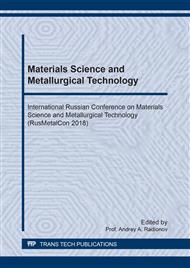[1]
L. Sinclair, J. Thompson, In situ leaching of copper: challenges and future prospects, Hydrometallurgy. 157 (2015) 306-324.
DOI: 10.1016/j.hydromet.2015.08.022
Google Scholar
[2]
D. A. Singer, Future copper resources, Ore Geology Reviews. 86 (2017) 271-279.
DOI: 10.1016/j.oregeorev.2017.02.022
Google Scholar
[3]
R.G. McDonald, D.M. Muir, Pressure oxidation leaching of chalcopyrite 1. Comparison of high and low temperature reaction kinetics and products, Hydrometallurgy. 86 (2007) 191-205.
DOI: 10.1016/j.hydromet.2006.11.015
Google Scholar
[4]
I.V. Ukraintsev, G.V. Petrov, B.S. Ivanov, A.Ya. Boduen, Autoclave conditioning of a low-grade sulphide copper concentrate, Tsvetnye Metally. 10 (2016) 43-48.
DOI: 10.17580/tsm.2016.10.06
Google Scholar
[5]
D.A. Rogozhnikov, B.V. Kolmachikhin, Polymetallic ore concentration middlings Nitric Acid leaching kinetics, Solid State Phenomena. 265 (2017) 1065-1070.
DOI: 10.4028/www.scientific.net/ssp.265.1065
Google Scholar
[6]
D.A. Rogozhnikov, S.V. Mamyachenkov, O.S. Anisimova, Nitric Acid Leaching of Copper-Zinc Sulfide Middlings, Metallurgist. 60 (2016) 229-233.
DOI: 10.1007/s11015-016-0278-7
Google Scholar
[7]
C.G. Anderson, The Optimization, Design and Economics of Industrial NSC Oxidative Pressure Leaching Of Complex Sulfide Concentrates, Inter. J. of Eng. and Science. 2 (2013) 01-16.
Google Scholar
[8]
Y. Dong, H. Lin, X. Xu, S. Zhou, Bioleaching of different copper sulfides by Acidithiobacillus ferrooxidans and its adsorption on minerals, Hydrometallurgy. 140 (2013) 42-47.
DOI: 10.1016/j.hydromet.2013.05.009
Google Scholar
[9]
T. Khonthu, J. Wiese, C.T. O'Connor, A comparative study of the flotation performance of ores treated in an IsaMill and a ball mill, IMPC 2012. 26 (2012) 2421-2428.
Google Scholar
[10]
X. Ye, S. Gredelj, W. Skinner, S.R. Grano, Regrinding sulphide minerals - Breakage mechanisms in milling and their influence on surface properties and flotation behavior, Powder Technology. 203 (2010) 133-147.
DOI: 10.1016/j.powtec.2010.05.002
Google Scholar
[11]
S. Palaniandy, Impact of mechanochemical effect on chalcopyrite leaching, Int. J. Miner. Process. 136 (2015) 56-65.
Google Scholar
[12]
X. Ma, J. Yang, H. Ma, C. Liu, Hydrothermal extraction of potassium from potassic quartz syenite and preparation of aluminum hydroxide, Int. J. Miner. Process. 147 (2016) 10-17.
DOI: 10.1016/j.minpro.2015.12.007
Google Scholar
[13]
A.K. Majumder, B. Govindarajan, T. Sharma, H.S. Ray, T.C. Rao, An empirical model for chloridising-roasting of potassium in glauconitic sandstone, Int. J. Miner. Process. 43 (1995) 81-89.
DOI: 10.1016/0301-7516(94)00041-w
Google Scholar
[14]
S.K. Jena, N. Dhawan, D.S. Rao, P.K. Misra, B.K. Mishra, B. Das, Studies on extraction of potassium values from nepheline syenite, Int. J. Miner. Process. 133 (2014) 13-22.
DOI: 10.1016/j.minpro.2014.09.006
Google Scholar
[15]
Y.M. Nie, H.W. Ma, H. Liu, P. Zhang, M.Y. Qiu, L. Wang, Reactive mechanism of potassium feldspar dissolution under hydrothermal condition, J. Chin. Ceram. Soc. 34 (2006) 846-850.
Google Scholar
[16]
A.А. Shoppert, I. V. Loginova, L. I. Chaikin, and D. A. Rogozhnikov, Alkali fusion-leaching method for comprehensive processing of fly ash, Technogen Conference Proceedings, KnE Materials Science. 1 (2017) 89-96.
DOI: 10.18502/kms.v2i2.952
Google Scholar
[17]
J. Chen, J. Yang, H. Ma, Preparation of nano-sized wollastonite using calcium silicate residue of potassium feldspar after extraction of potassium and alumina, Key Eng. Mat. 633 (2014) 35-38.
DOI: 10.4028/www.scientific.net/kem.633.35
Google Scholar
[18]
P. Smith, The processing of high silica bauxites — Review of existing and potential processes, Hydrometallurgy. 98 (2009) 162-176.
DOI: 10.1016/j.hydromet.2009.04.015
Google Scholar
[19]
Y. Guo, Q. Zhao, K. Yan, F. Cheng, H.H. Lou, Novel process for alumina extraction via the coupling treatment of coal gangue and bauxite red mud, Ind. and Eng. Chem. Research, 53 (2014) 4518-4521.
DOI: 10.1021/ie500295t
Google Scholar
[20]
X.F. Zhu, T.A. Zhang, Y.X. Wang, G.Z. Lü, W.G. Zhang, Recovery of alkali and alumina from Bayer red mud by the calcification–carbonation method, Int. J. of Miner., Met. and Materials. 23 (2016) 257-268.
DOI: 10.1007/s12613-016-1234-z
Google Scholar
[21]
P.J. Cresswell, I.L. Grayson, A.H. Smith, U.S. Patent 4668485-A. (1986).
Google Scholar


